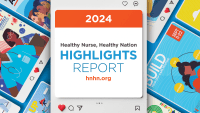Incorporate coping strategies into the curriculum.
- Nursing students report stress related to academic and clinical settings.
- Nurse educators can role-model self-care behaviors to promote students’ personal health and wellness.
- Nursing students need to make time for their own self-care, and they need to know that it’s okay to make time for their personal health and wellness.
Go, “Nurse Linck,” my coach cheered during track practices. That’s when I (Monforto) realized I was transitioning from a student athlete to a soon-to-be new graduate nurse. Since then, I’ve earned an MSN and a PhD, but it was my undergraduate experience that ignited my desire to teach in higher education, which then provided me with greater insight into the stress of nursing students.
Undergraduate nurse stress
International nursing literature documents the stress experienced by nursing students. According to Crary, simultaneous didactic and clinical experiences present nursing students with unique challenges compared to other health profession students, who don’t participate in these concurrent experiences at the undergraduate level. Nursing students report stress related to teachers and nursing staff, rejection by peers and patients, feelings of inadequacy, self-doubt, unpreparedness, lack of knowledge and skills, fear of making mistakes, heavy workloads, fear of failure related to graduation, coursework, clinicals, the NCLEX-RN, and time management.
Dedicated academic advisors for nursing student athletes
Group work in higher education
Addressing stress experienced by undergraduate nursing students can prove complex. However, nurse educators can play a prominent role in their self-care and wellness.
Call to action
During the COVID-19 pandemic, which highlighted undergraduate nursing students’ stress, the American Association of Colleges of Nursing (AACN) released The Essentials: Core Competencies for Professional Nursing Education. Domain 10 of the document highlights Personal, Professional, and Leadership Development with a goal for graduates to “Demonstrate healthy, self-care behaviors that promote wellness and resiliency.” AACN defines self-care as “the act of attending to one’s physical or mental health, generally without medical or other professional consultation.” Nursing students diagnosed with generalized anxiety disorder, clinical depression, or other mental health disorders require treatment and counseling from a healthcare provider. Those conditions are beyond the scope of this article.
Many studies that focus on managing stress in nursing students advocate for schools to include education about self-care practices. Researchers suggest that these practices should contain empirically tested approaches to prevent the recurrence of stress and reduce its impact, content and skill-building for coping and stress management, and problem-based strategies that include staying optimistic, adopting various approaches to solve problems, and finding meaning in stressful events rather than using emotion-based behaviors (for example, eating large meals, watching television, sleeping). Cochran and colleagues surveyed a random sample of 155 schools of nursing and discovered that only nine reported including resilience training within their curriculums.
Most literature includes self-care activities embedded into one course as opposed to the entire curriculum. For example, Snyder incorporated self-care activities (guided meditation, progressive muscle relaxation, coloring pages, creative journaling, gratitude lists, positive affirmations, and breathing exercises) during the last 5 to 10 minutes of each class in an undergraduate psychiatric-mental health nursing course. Snyder presented these as activities students could do themselves as well as teach patients. The students expressed positive perceptions of these in-class self-care activities.
Jenkins and colleagues surveyed students after they completed a required self-care assignment in which they shared stressors and self-care activities. Students felt the assignment supported their well-being; however, assigning grades detracted from some students’ well-being, and the expectation that they use personal time for self-care contributed to feelings of guilt. As a result, Jenkins and colleagues recommended alternative grading systems and embedding self-care throughout the curriculum, such as in one course per semester or at the beginning of class, during lunchtime, and as facilitated debriefings for academic and clinical challenges.
Provision 5.2 of the American Nurses Association (ANA) Code of Ethics for Nurses with Interpretive Statements promotes nurses’ personal health, safety, and well-being. Nurses care for and educate patients about self-care, but we also must take appropriate steps to care for ourselves by incorporating good nutrition, exercise, rest, leisure, personal relationships, and spirituality into our lives. Nurses can role-model these behaviors for patients, and nurse leaders (such as faculty) can do the same for students. Nursing school administrators, faculty, and staff must focus attention on the curriculum as one way to promote student wellness. In addition, faculty can help nursing students develop life-long habits for self-care, stress management, and resilience, and address the unique stressors they experience.
The interprofessional nature of healthcare and nursing requires us to recognize that promoting personal health and wellness is crucial not only for nursing students and nurses, but also for all healthcare workers. The National Academy of Medicine developed the National Plan for Health Workforce Well-Being to improve the well-being of all healthcare workers and subsequently the care they provide to patients.
Nursing student athletes
Being a student–athlete can add to the stress of college; however, many benefits can transfer into the clinical setting. Engelke and Frederickson conducted a phenomenological study to understand the meaning of the collegiate roles of the nursing student and the student athlete. When they interviewed RNs who were former nursing student athletes (NSAs), four themes emerged: athletic identity, perseverance, advocates and adversaries, and belongingness. Many of the NSAs chose their university specifically so they could play their sport and study nursing. However, some college coaches don’t recruit nursing majors due to the rigorous academic program and clinical expectations. When a compromise between their sport and major wasn’t possible, the study participants reported that they chose nursing and described the experience of losing their athletic identity.
Study participants who found a way to pursue both nursing and their sport mentioned advocates who helped them succeed—nursing peers who took notes for them, professors who arranged alternate exam schedules, and coaches who allowed them to make up practices individually. Many participants also identified adversaries, including peers, faculty, or coaches who didn’t understand what it was like to be an NSA or encouraged them to quit nursing or their sport.
All participants felt a strong sense of belonging through their sport (friends, a place to go, comfort). They also discussed how their NSA experience transferred into their professional nursing career. As part of an athletic team, they gained skills in communication, constructive criticism, and leadership, as well as the ability to handle pressure, manage time, and organize.
Reflecting on my own experiences as an NSA, I don’t recall an intense sense of stress. Perhaps because I had a built-in support system of teammates, and I maintained a high level of physical activity. The term “self-care” didn’t come up during my undergraduate experience.
For 17 years I stopped running because of career, family, and educational commitments, but restarted 3 years before the pandemic when my children were older and after I completed my doctorate. I joined a community running group and frequently ran with others and competed in local races. However, it wasn’t until the pandemic that I realized that running is my form of self-care. During the height of the pandemic, a childhood friend (also a collegiate runner) formed an online running group and created individualized running plans for members. I enjoyed these workouts as an outlet for the uncertainty of the pandemic and its impact on me as a nurse educator.
Self-care in the classroom
The National Plan for Health Workforce Well-Being prioritizes creating positive work and learning environments. As a nurse educator, I have a responsibility to establish a classroom environment that nurtures students’ personal health and wellness.
When I introduce myself at the beginning of the semester, I tell students about my professional journey, including my history as an NSA. Due to the influences of the pandemic on collegiate sports, several NSAs have met with me to discuss their athletic endeavors and academic pursuits. I listen to their concerns and provide suggestions.
Most nursing students aren’t athletes. However, engaging in an enjoyable activity that brings structure to one’s schedule can prove beneficial. Nursing has a goal to integrate self-care behaviors into nursing curriculums, and individual nurse educators can discuss self-care strategies with students in their classrooms.
On the first day of class, I tell students that stress is a part of life and that we all must find strategies to manage it for our own personal health and wellness. When they graduate and become RNs, they’ll experience stress in that role as well. In the pediatrics course that I teach, we discuss that children need to learn how to cope with stress and parents must learn how to manage the stress of caring for a sick child. As nurses, we should ask our clients how they’ve positively dealt with past stressful events. These strategies may help them in a current stressful situation.
I integrate self-care in my classroom using several approaches. For example, I ask students to share one positive stress-relieving technique they use. Before they start sharing, I tell them that I run to manage stress. During this informal conversation, many students share that they exercise, go to the gym, spend time with friends, go for walks, read books, cook, listen to music, or interact with their pets. I recommend that students remember these strategies and use them throughout the semester. They can use these same strategies when they become nurses. They don’t need to learn a new technique; they just need to make time to use a positive strategy that they know helps.
I also reassure students that it’s okay to make time for their personal health and wellness. Throughout the semester, especially when I know students have a test or an assignment due, I remind them to use their stress-relieving techniques. During semester breaks, I tell students to enjoy time to themselves, and I try not to post announcements or send emails.
Recently, I posted links to stress management resources that students can access. One of those resources, the National Council for Mental Wellbeing, offers the following self-care tips for college students: set a routine, get 7 hours of sleep; exercise at least 20 minutes per day; eat nutritious meals; drink plenty of water; practice mindfulness, meditation, and gratitude; and maintain a clean, decluttered living space. These practices align with the ANA’s provision for personal health, safety, and well-being.
In the nursing research and evidence-based practice (EBP) course I teach, I added population, intervention, comparison, outcome, time (PICOT) questions related to the use of mindfulness or aromatherapy and their effect on undergraduate nursing students’ anxiety or test anxiety. I want students to explore EBP interventions related to their student nurse role. In the pediatrics course, students present an article about research, EBP, or quality improvement that relates to the population they care for on their designated clinical unit. I started to encourage them to choose an article related to nurse self-care.
According to Labrague and colleagues, students experience stress related to assignments and workloads. I reviewed the evaluation methods used in my courses as well as feedback from students to adjust or remove assignments and recalculate the weight of assignments. These changes continue to align with student learning outcomes and course objectives.
While obtaining my doctoral degree, a professor encouraged my cohort to celebrate our milestones within the program. I’ve embedded this approach into my teaching. In addition to reaching out to students who don’t perform well on exams, I also send individual recognition emails to congratulate the top performing students on each exam. I want to support all students—those who are struggling and those who are succeeding. Recognizing students’ achievements can promote retention and engage them in their professional development. I also ask students, if they’re willing, to share their exam preparation strategies so I can provide them to other students (I keep student names private). Sharing best practices can help promote success among all students. I compiled these strategies onto slides, which I review during the first day of class and keep posted throughout the course. (See Educator recommendations.)
Educator recommendations
If you’re an educator, consider encouraging nursing student self-care with the following strategies:
- Ask students to identify their positive self-care behaviors.
- Encourage students to incorporate their self-care behavior throughout the semester.
- Reassure students that it’s okay to make time for themselves.
- Encourage students to enjoy time to themselves.
- Embed assignments or activities related to self-care into the course.
- Avoid posting announcements or sending emails during extended breaks from school.
- Consider adjusting, decreasing, or removing class assignments and recalculating the weight of assignments.
- Acknowledge student success in classroom and clinical settings.
Putting words into action
As a nurse educator in higher education, I try to role-model the Code’s provisions related to promoting health, safety, and well-being. I recently joined a running group at my university. Some of my students have seen me run to or from the track to join the group. Recently, I trained for and completed my first-ever marathon in the city where I teach. When my schedule seemed too hectic to squeeze a run in for training, I thought of my students—I tell them to make time for their stress relievers, so I should too. The perfect ending to the marathon occurred when a student athlete at my university handed me my finisher’s medal.
Kathleen Monforto is an assistant professor at La Salle University and a per diem education nurse specialist at Children’s Hospital of Philadelphia in Philadelphia, Pennsylvania. Elizabeth Mancini is enrolled in the family nurse practitioner program at La Salle University and was a student–athlete on the cross country and track teams.
American Nurse Journal. 2023; 18(11). Doi: 10.51256/ANJ1123100
References
American Association of Colleges of Nursing. The Essentials: Core Competencies for Professional Nursing Education. 2021. aacnnursing.org/Portals/0/PDFs/Publications/Essentials-2021.pdf
American Nurses Association. Code of Ethics for Nurses with Interpretive Statements. 2015. nursingworld.org/practice-policy/nursing-excellence/ethics/code-of-ethics-for-nurses/coe-view-only/
Bhurtun HD, Azimirad M, Saaranen T, Turunen H. Stress and coping among nursing students during clinical training: An integrative review. J Nurs Educ. 2019;58(5):266-72. doi:10.3928/0148434-20190422-04
Cochran KL, Moss M, Mealer M. Prevalence of coping strategy training in nursing school curricula. Am J Crit Care. 2020;29(2):104-10. doi:10.4037/ajcc2020287
Crary P. Beliefs, behaviors, and health of undergraduate nursing students. Holist Nurs Pract. 2013;27(2):74-88. doi:10.1097/HNP.0b013e318280f75e
Engelke EC, Frederickson K. Dual collegiate roles—The lived experience of nursing student athletes. J Nurs Educ. 2022;61(3):117-22. doi:10.3928/01484834-20220109-01
Jenkins EK, Slemon A, O’Flynn-Magee K, Mahy J. Exploring the implications of a self-care assignment to foster undergraduate nursing student mental health: Findings from a survey research study. Nurse Educ Today. 2019;81:13-8. doi:10.1016/j.nedt.2019.06.009
Labrague LJ, McEnroe-Petitte DM, Papathanasiou IV, et al. Stress and coping strategies among nursing students: An international study. J Ment Health. 2018;27(5):402-8. doi:10.1080/09638237.2017.1417552
Mental Health First Aid USA. Seven self-care tips for college students. National Council for Mental Wellbeing. August 15, 2022. mentalhealthfirstaid.org/2022/08/seven-self-care-tips-for-college-students
National Academy of Medicine. National Plan for Health Workforce Well-being. Washington, DC: National Academies Press; 2022. doi:10.17226/26744
Overbaugh KJ, Monforto K, DiGiacomo P, Maloney C. Understanding COVID-19’s impact on nursing students’ education, professional perceptions, stress, and coping. Nurs Educ Perspect. 2022;43(6):E47-9. doi:10.1097/01.NEP.0000000000001043
Reeve KL, Shumaker CJ, Yearwood EL, Crowell NA, Riley JB. Perceived stress and social support in undergraduate nursing students’ educational experiences. Nurse Educ Today. 2013;33(4):419-24. doi:10.1016/j.nedt.2012.11.009
Snyder BL. Practicing what we preach: Teaching psychiatric-mental health student nurses to care for themselves. J Psychosoc Nurs Ment Health Serv. 2020;58(6):40-5. doi:10.3928/02793695-20200406-02
Wolf L, Stidham AW, Ross R. Predictors of stress and coping strategies of US accelerated vs. generic baccalaureate nursing students: An embedded mixed methods study. Nurse Educ Today. 2015;35:201-5. doi:10.1016/j.nedt.2014.07.005
Key words: student nurse, self-care, stress, well-being, role-modeling



















1 Comment. Leave new
Great article! Definitely one that I will keep referring back to in the future!